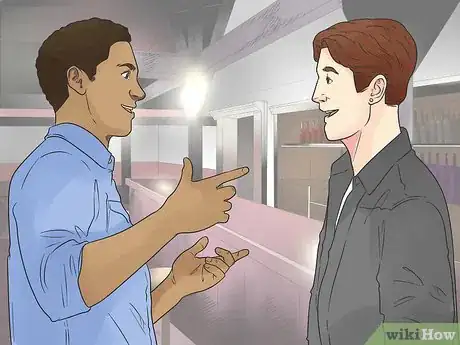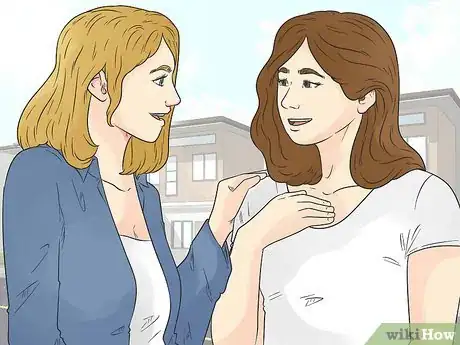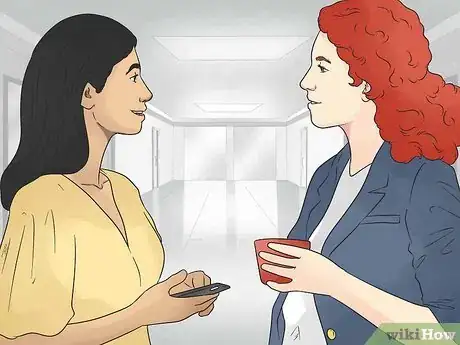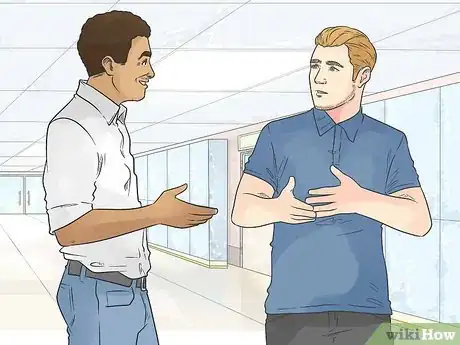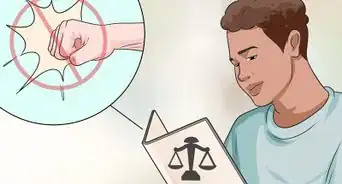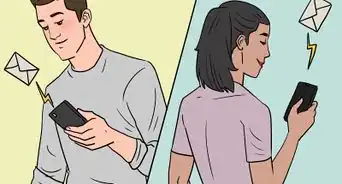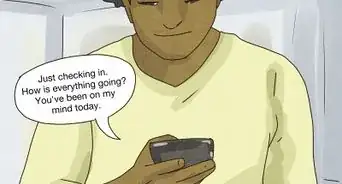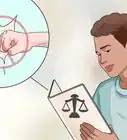This article was co-authored by Lynda Jean and by wikiHow staff writer, Jennifer Mueller, JD. Lynda Jean is an Image Consultant and the Owner of Lynda Jean Image Consulting. With over 15 years of experience, Lynda specializes in color and body/style analysis, wardrobe audits, personal shopping, social and professional etiquette, and personal and business branding. She works with clients to enhance their image, self-esteem, behavior, and communication to facilitate their social and career goals. Lynda holds Bachelor degrees in Sociology and Social Work, a Master’s degree in Clinical Social Work, and a Certified Image Consultant (CIC) certification. She studied Image Consulting at the International Image Institute and the International Academy of Fashion and Technology in Toronto, Canada. Lynda has taught Image Consulting courses at George Brown College in Toronto, Canada. She is the co-author of the book, “Business Success With Ease,” where she shares her knowledge about, ‘The Power of Professional Etiquette.’
There are 10 references cited in this article, which can be found at the bottom of the page.
This article has been viewed 5,853 times.
You're having a conversation, the other person stops talking, and you immediately freeze up. There's an awkward silence while you try to figure out what to say. Sound familiar? Or maybe someone's telling you about something difficult or personal and you just don't know what you can say to make them feel at ease. If you have a hard time coming up with the right thing to say at the right time, we've got you covered! Here, we've gathered some tips you can put into practice next time you're worried about what to say.
Steps
Expert Q&A
-
QuestionHow can I start a conversation with someone?
 Lynda JeanLynda Jean is an Image Consultant and the Owner of Lynda Jean Image Consulting. With over 15 years of experience, Lynda specializes in color and body/style analysis, wardrobe audits, personal shopping, social and professional etiquette, and personal and business branding. She works with clients to enhance their image, self-esteem, behavior, and communication to facilitate their social and career goals. Lynda holds Bachelor degrees in Sociology and Social Work, a Master’s degree in Clinical Social Work, and a Certified Image Consultant (CIC) certification. She studied Image Consulting at the International Image Institute and the International Academy of Fashion and Technology in Toronto, Canada. Lynda has taught Image Consulting courses at George Brown College in Toronto, Canada. She is the co-author of the book, “Business Success With Ease,” where she shares her knowledge about, ‘The Power of Professional Etiquette.’
Lynda JeanLynda Jean is an Image Consultant and the Owner of Lynda Jean Image Consulting. With over 15 years of experience, Lynda specializes in color and body/style analysis, wardrobe audits, personal shopping, social and professional etiquette, and personal and business branding. She works with clients to enhance their image, self-esteem, behavior, and communication to facilitate their social and career goals. Lynda holds Bachelor degrees in Sociology and Social Work, a Master’s degree in Clinical Social Work, and a Certified Image Consultant (CIC) certification. She studied Image Consulting at the International Image Institute and the International Academy of Fashion and Technology in Toronto, Canada. Lynda has taught Image Consulting courses at George Brown College in Toronto, Canada. She is the co-author of the book, “Business Success With Ease,” where she shares her knowledge about, ‘The Power of Professional Etiquette.’
Certified Image Consultant You can smile and make good eye contact with the person and talk about general things.
You can smile and make good eye contact with the person and talk about general things. -
QuestionWhat are the suitable and unsuitable topics for your first conversation?
 Lynda JeanLynda Jean is an Image Consultant and the Owner of Lynda Jean Image Consulting. With over 15 years of experience, Lynda specializes in color and body/style analysis, wardrobe audits, personal shopping, social and professional etiquette, and personal and business branding. She works with clients to enhance their image, self-esteem, behavior, and communication to facilitate their social and career goals. Lynda holds Bachelor degrees in Sociology and Social Work, a Master’s degree in Clinical Social Work, and a Certified Image Consultant (CIC) certification. She studied Image Consulting at the International Image Institute and the International Academy of Fashion and Technology in Toronto, Canada. Lynda has taught Image Consulting courses at George Brown College in Toronto, Canada. She is the co-author of the book, “Business Success With Ease,” where she shares her knowledge about, ‘The Power of Professional Etiquette.’
Lynda JeanLynda Jean is an Image Consultant and the Owner of Lynda Jean Image Consulting. With over 15 years of experience, Lynda specializes in color and body/style analysis, wardrobe audits, personal shopping, social and professional etiquette, and personal and business branding. She works with clients to enhance their image, self-esteem, behavior, and communication to facilitate their social and career goals. Lynda holds Bachelor degrees in Sociology and Social Work, a Master’s degree in Clinical Social Work, and a Certified Image Consultant (CIC) certification. She studied Image Consulting at the International Image Institute and the International Academy of Fashion and Technology in Toronto, Canada. Lynda has taught Image Consulting courses at George Brown College in Toronto, Canada. She is the co-author of the book, “Business Success With Ease,” where she shares her knowledge about, ‘The Power of Professional Etiquette.’
Certified Image Consultant After your initial exchanges with someone, you can talk about a book you read, a movie, or something you find interesting on Netflix. Avoid talking about politics and religion in your first conversation.
After your initial exchanges with someone, you can talk about a book you read, a movie, or something you find interesting on Netflix. Avoid talking about politics and religion in your first conversation. -
QuestionHow do you have a great conversation and keep it going?
 Lynda JeanLynda Jean is an Image Consultant and the Owner of Lynda Jean Image Consulting. With over 15 years of experience, Lynda specializes in color and body/style analysis, wardrobe audits, personal shopping, social and professional etiquette, and personal and business branding. She works with clients to enhance their image, self-esteem, behavior, and communication to facilitate their social and career goals. Lynda holds Bachelor degrees in Sociology and Social Work, a Master’s degree in Clinical Social Work, and a Certified Image Consultant (CIC) certification. She studied Image Consulting at the International Image Institute and the International Academy of Fashion and Technology in Toronto, Canada. Lynda has taught Image Consulting courses at George Brown College in Toronto, Canada. She is the co-author of the book, “Business Success With Ease,” where she shares her knowledge about, ‘The Power of Professional Etiquette.’
Lynda JeanLynda Jean is an Image Consultant and the Owner of Lynda Jean Image Consulting. With over 15 years of experience, Lynda specializes in color and body/style analysis, wardrobe audits, personal shopping, social and professional etiquette, and personal and business branding. She works with clients to enhance their image, self-esteem, behavior, and communication to facilitate their social and career goals. Lynda holds Bachelor degrees in Sociology and Social Work, a Master’s degree in Clinical Social Work, and a Certified Image Consultant (CIC) certification. She studied Image Consulting at the International Image Institute and the International Academy of Fashion and Technology in Toronto, Canada. Lynda has taught Image Consulting courses at George Brown College in Toronto, Canada. She is the co-author of the book, “Business Success With Ease,” where she shares her knowledge about, ‘The Power of Professional Etiquette.’
Certified Image Consultant You can use their name and show interest in what they're saying. Listen attentively and ask relevant questions.
You can use their name and show interest in what they're saying. Listen attentively and ask relevant questions.
References
- ↑ https://www.ncbi.nlm.nih.gov/pmc/articles/PMC3776723/
- ↑ https://youtu.be/TKciOG54eWE?t=110
- ↑ Lynda Jean. Certified Image Consultant. Expert Interview. 17 November 2020.
- ↑ https://www.edutopia.org/blog/teaching-your-students-conversation-allen-mendler
- ↑ https://www.edutopia.org/blog/teaching-your-students-conversation-allen-mendler
- ↑ Lynda Jean. Certified Image Consultant. Expert Interview. 17 November 2020.
- ↑ https://www.edutopia.org/blog/teaching-your-students-conversation-allen-mendler
- ↑ https://www.understood.org/articles/en/4-parts-of-a-conversation-how-to-help-kids-with-social-skills-issues-navigate
- ↑ https://www.fastcompany.com/3027801/5-ways-to-have-great-conversations
- ↑ https://www.psychologytoday.com/us/blog/fulfillment-any-age/201712/10-must-know-tips-making-better-conversations
- ↑ https://www.understood.org/articles/en/4-parts-of-a-conversation-how-to-help-kids-with-social-skills-issues-navigate
- ↑ https://www.entrepreneur.com/article/235615
- ↑ https://edu.gcfglobal.org/en/business-communication/improve-your-conversation-skills/1/
- ↑ Lynda Jean. Certified Image Consultant. Expert Interview. 17 November 2020.
- ↑ https://www.fastcompany.com/3027801/5-ways-to-have-great-conversations
- ↑ https://www.understood.org/articles/en/4-parts-of-a-conversation-how-to-help-kids-with-social-skills-issues-navigate
- ↑ https://www.toastmasters.org/magazine/articles/the-art-of-small-talk








